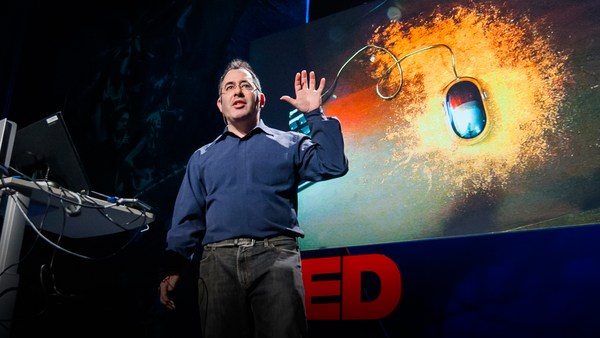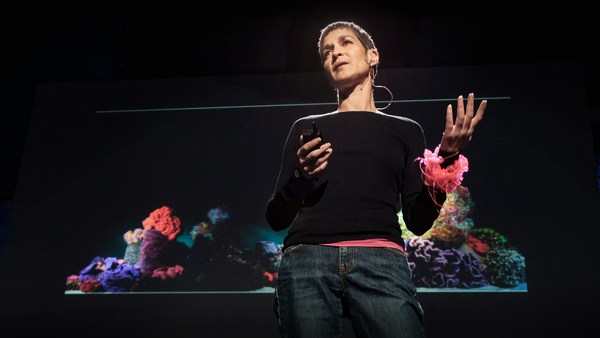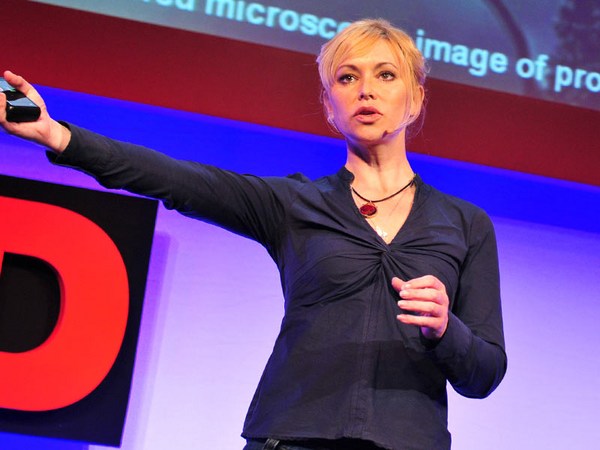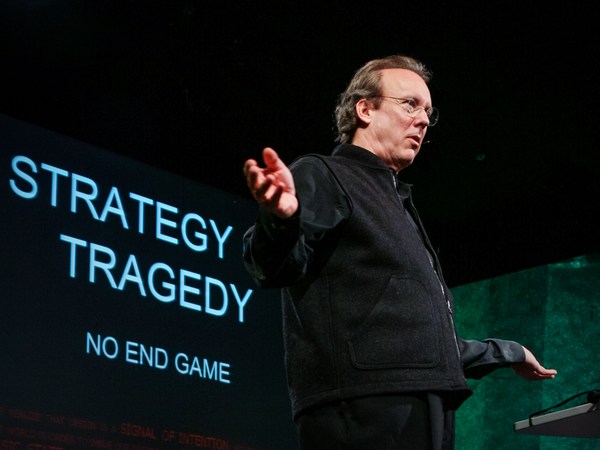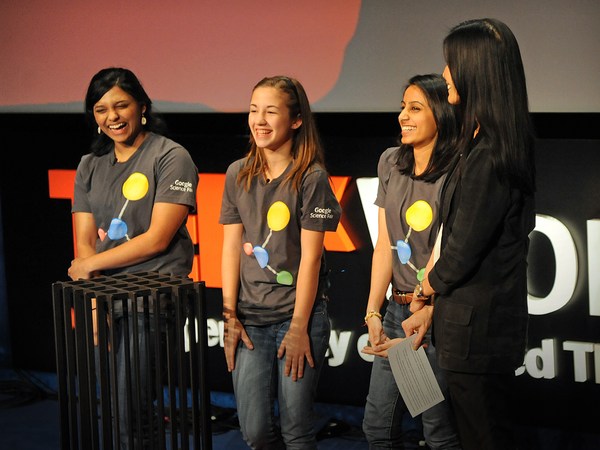I was informed by this kind of unoriginal and trite idea that new technologies were an opportunity for social transformation, which is what drove me then, and still, it's a delusion that drives me now. I wanted to update what I've been doing since then -- but it's still the same theme song -- and introduce you to my lab and current work, which is the Environmental Health Clinic that I run at NYU. And what it is -- it's a twist on health. Because, really, what I'm trying to do now is redefine what counts as health. It's a clinic like a health clinic at any other university, except people come to the clinic with environmental health concerns, and they walk out with prescriptions for things they can do to improve environmental health, as opposed to coming to a clinic with medical concerns and walking out with prescriptions for pharmaceuticals.
It's a handy-dandy quote from Hippocrates of the Hippocratic oath that says, "The greater part of the soul lays outside the body, treatment of the inner requires treatment of the outer." But that suggests the issue that I'm trying to get at here, that we have an opportunity to redefine what is health. Because this idea that health is internal and atomized and individual and pharmaceutical is largely an error. And I would use this study, a recent study by Philip Landrigan, to motivate a different view of health, where he went to most of the pediatricians in Manhattan and the New York area and logged what they spent their patient hours on. 80 to 90 percent of their time was spent on five things. Number one was asthma, number two was developmental delays, number three was 400-fold increases in rare childhood cancers in the last eight to 10, 15 years. Number four and five were childhood obesity and diabetes-related issues. So all of those -- what's common about all of those? The environment is implicated, radically implicated, right. This is not the germs that medicos were trained to deal with; this is a different definition of health, health that has a great advantage because it's external, it's shared, we can do something about it, as opposed to internal, genetically predetermined or individualized.
People who come to the clinic are called, not patients, but impatients, because they're too impatient to wait for legislative change to address local and environmental health issues. And I meet them at the University, I also have a few field offices that I set up in various places that provide an immersion in some of the environmental challenges we face. I like this one from the Belgian field office, where we met in a roundabout, precisely because the roundabout iconified the headless social movement that informs much social transformation, as opposed to the top-down control of red light traffic intersections. In this case, of course, the roundabout with that micro-decisions being made in situ by people not being told what to do. But, of course, affords greater throughput, fewer accidents, and an interesting model of social movement.
Some of the things that the monitoring protocols have developed: this is the tadpole bureaucrat protocol, or keeping tabs, if you will. What they are is an addition of tadpoles that are named after a local bureaucrat whose decisions affect your water quality. So an impatient concerned for water quality would raise a tadpole bureaucrat in a sample of water in which they're interested. And we give them a couple of things to do that, to help them do companion animal devices while they're blogging and doing their email. This is a tadpole walker to take your tadpole walking in the evening. And the interesting thing that happens -- because we're using tadpoles, of course, because they have the most exquisite biosenses that we have, several orders of magnitude more sensitive than some of our senses for sensing, responding in a biologically meaningful way, to that whole class of industrial contaminants we call endocrine disruptors or hormone emulators.
But by taking your tadpole out for a walk in the evening -- there's a few action shots -- your neighbors are likely to say, "What are you doing?" And then you have to introduce your tadpole and who it's named after. You have to explain what you're doing and how the developmental events of a tadpole are, of course, very observable and they use the same T3-mediated hormones that we do. And so next time your neighbor sees you they'll say, "How is that tadpole doing?" And you can let them social network with your tadpole, because the Environmental Health Clinic has a social networking site for, not only impatients, humans, but non-humans, social networking for humans and non-humans. And of course, these endocrine disruptors are things that are implicated in the breast cancer epidemic, the obesity epidemic, the two and a half year drop in the average age of onset of puberty in young girls and other related things. The culmination of this is if you've successfully raised your tadpole, observing the behavioral and developmental events, you will then go and introduce your tadpole to its namesake and discuss the evidence that you've seen.
Another quick protocol -- and I'm going to go through these quickly, but just to give you the material sense of what we're doing here -- instead of asking you for urine samples, I'll ask you for a mouse sample. Anyone here lucky enough to share, to cohabit with a mouse -- a domestic partnership with mice? Very lucky. Mice, of course, are the quintessential model organism. They're even better models of environmental health, because not only the same mammalian biology, but they share your diet, largely. They share your environmental stressors, the asbestos levels and lead levels, whatever you're exposed to. And they're geographically more limited than you are, because we don't know if you've been exposed to persistent organic pollutants in your home, or occupationally or as a child. Mice are a very good representation. So it starts by building a better mousetrap, of course. This is one of them.
Coping with environmental stressors is tricky. Is anybody here on antidepressants? (Laughter) There's a lot of people in Manhattan are. And we were testing if the mice would also self-administer SSRIs. So this was Prozac, this was Zoloft, this was a black jellybean and this was muscle relaxant, all of which were the medications that the impatient was taking. So do you think the mice self-administered antidepressants? What's the -- (Audience: Sure. Yes.) How did you know that? They did. This was vodka and solution, gin and solution. This guy also liked plain water and the muscle relaxant. Where's our expert? Vodka, gin -- (Audience: [unclear]) Yes. Yes. You know your mice well. They did, yes. So they drank as much vodka as they did plain water, which was interesting. Then of course, it goes into the entrapment device. There's an old cellphone in there -- a good use for old cellphones -- which dials the clinic, we go and pick up the mouse. We take the blood sample and do the blood work and hair work on the mice.
And I want to sort of point out the big advantage of framing health in this external way. But we do have a few prescription products through this. It's very different from the medical model. Anything you do to improve your water quality or air quality, or to understand it or to change it, the benefits are enjoyed by anyone you share that water quality or air quality with. And that aggregating effect, that collective action effect, is actually something we can use to our advantage. So I want to show you one prescription product in the clinic called the No Park. This is a prescription to improve water quality. Many impatients are very concerned for water quality and air quality. What we do is we take a fire hydrant, a "no parking" space associated with a fire hydrant, and we prescribe the removal of the asphalt to create an engineered micro landscape, to create an infiltration opportunity.
Because, many of you will know, that the biggest pollution burden that we have on the New York, New Jersey harbor right now is no longer the point sources, no longer the big polluters, no longer the GEs, but that massive network of roads, [those] impervious surfaces, that collect all that cadmium neurotoxin that comes from your brake liners or the oily hydrocarbon waste in every single storm event and medieval infrastructure washes it straight into the estuary system. That doesn't do a lot of good. These are little opportunities to intercept those pollutants before they enter the harbor, and they're produced by impatients on various city blocks in some very interesting ways. I just want to say it was sort of a rule of thumb though, there's about two or three fire hydrants on every city block. By creating engineered micro landscapes to infiltrate in them, we don't prevent them from being used as emergency vehicle parking spaces, because, of course, a firetruck can come and park there. They flatten a few plants. No big deal, they'll regenerate. But if we did this in every single -- every fire hydrant we could redefine the emergency. That 99 percent of the time when a firetruck is not parking there, it's infiltrating pollutants. It's also increasing fixing CO2s, sequestering some of the airborne pollutants. And aggregated, these smaller interceptions could actually infiltrate all the roadborne pollution that now runs into the estuary system, up to a seven inch rain event, up to a hundred-year storm.
So these are small actions that can amount to a significant effect to improve local environmental health. This is one of the more ambitious ones. What the climate crisis has revealed to us is a secondary, more insidious and more pervasive crisis, which is the crisis of agency, which is what to do. Somehow buying a local lettuce, changing a light bulb, driving the speed limit, changing your tires regularly, doesn't seem sufficient in the face of climate crisis. And this is an interesting icon that happened -- you remember these: fallout shelters. What is the fallout shelter for the climate crisis? This was civic mobilization. Churches, school groups, hospitals, private residents -- everyone built one of these in a matter of months. And they still remain as icons of civic response in the face of shared, uncertain, collective threat.
Fallout shelter for the climate crisis, I would say, looks something like this, or this, which is an intensive urban agriculture facility that's due to go on my lab building at NYU. What it does is a very simple idea of taking -- 80 to 90 percent of the CO2 produced in Manhattan is building related -- we take, just like a commercial greenhouse, we take the CO2 from the building -- CO2-enriched air -- we force it through the urban agriculture facility, and then we resupply oxygen-enriched air. You can't actually build much on a roof, they're not designed for that. So it's on legs, so it focuses all the load on the masonry walls and the columns. It's built as a barn raising, using open source hardware. This is the quarter-scale prototype that was functioning in Spain. This is what it will look like, fingers crossed, NYU willing.
And what I want to show you is -- actually this is one of the components of it that we've just recently been testing -- which is a solar chimney -- we have got 17 of them now put around New York at the moment -- that passively draws air up. You understand a solar chimney. Hot air rises. You put a bit of black plastic on the side of a building, it'll heat up, and you'll get passive airflow. What we do is actually put a standard HVAC filter on the top of that. That actually removes about 95 percent of the carbon black, that stuff that, with ozone, is responsible for about half of global warming's effects, because it changes, it settles on the snow, it changes the reflectors, it changes the transmission qualities of the atmosphere. Carbon black is that grime that otherwise lodges in your pretty pink lungs, and it's associated with. It's not good stuff, and it's from inefficient combustion, not from combustion itself. When we put it through our solar chimney, we remove actually about 95 percent of that. And then I swap it out with the students and actually re-release that carbon black. And we make pencils the length of which measures the grime that we've pulled out of the air. Here's one of them that we have up now. Here's who put them up and who are avid pencil users.
Okay, so I want to show you just two more interfaces, because I think one of our big challenges is re-imagining our relationship to natural systems, not only through this model of twisted personalized health, but through the animals with whom we cohabit. We are not alone; the animals are moving in. In fact, urban migration now describes the movement of animals formerly known as wild into urban centers. You know, coyote in Central Park, a whale in the Gowanus Canal, elk in Westchester County. It's happening all over the Developed World, probably for loss of habitat, but also because our cities are a little bit more livable than they have been. And every green space we create is an invitation for non-humans to cohabit with us. But we've kind of lacked imagination in how we could do that well or interestingly. And I want to show you a few of the technological interfaces that have been developed under the moniker of OOZ -- which is zoo backwards and without cages -- to try and reform that relationship. This is communication technology for birds. It looks like this. When a bird lands on it, they trigger a sound file. This is actually in the Whitney Museum, where there were six of them, each of which had a different argument on it, different sound file. They said things like this.
(Whistling)
Recorded Voice: Here's what you need to do. Go down there and buy some of those health food bars, the ones you call bird food, and bring it here and scatter it around. There's a good person.
Natalie Jeremijenko: Okay. (Laugher) So there was several of these. The birds were able to jump from one to the other. These are just your average urban pigeon. And an early test which argument elicited cooperative behavior from the people below -- about a hundred to one decided that this was the argument that worked best on us.
Recorded Voice: Tick, tick, tick. That's the sound of genetic mutations of the avian flu becoming a deadly human flu. Do you know what slows it down? Healthy sub-populations of birds, increasing biodiversity generally. It is in your interests that I'm healthy, happy, well-fed. Hence, you could share some of your nutritional resources instead of monopolizing them. That is, share your lunch.
(Laughter)
NJ: It worked, and it's true. The final project I'd like to show you is a new interface for fish that has just been launched -- it's actually officially launched next week -- with a wonderful commission from the Architectural League. You may not have known that you need to communicate with fish, but there is now a device for you to do so. It looks like this: buoys that float on the water, project three foot up, three foot down. When a fish swims underneath, a light goes on. This is what it looks like. So there's another function on here. This top light is -- I'm sorry if I'm making you seasick -- this top light is actually a water quality display that shifts from red, when the dissolved oxygen is low, to a blue/green, when its dissolved oxygen is high. And then you can also text the fish. So there's business cards down there that'll give you contact details. And they text back. When the buoys get your text, they wink at you twice to say, we've got your message. But perhaps the most popular has been that we've got another array of these boys in the Bronx River, where the first beaver -- crazy as he is -- to have moved in and built a lodge in New York in 250 years, hangs out. So updates from a beaver. You can subscribe to updates from him. You can talk to him.
And what I like to think of is this is an interface that re-scripts how we interact with natural systems, specifically by changing who has information, where they have it, who can make sense of that information, and what you can do about it. In this case, instead of throwing chewing gum, or Doritos or whatever you have in your pocket at the fish -- There's a body of water in Iceland that I've been dealing with that's in the middle of the city, and the largest pollution burden on it is not the roadborne pollution, it's actually white bread from people feeding the fish and the birds. Instead of doing that actually, we've developed some fish sticks that you can feed the fish. They're delicious. They're cross-species delicious that is, delicious for humans and non-humans. But they also have a chelating agent in them. They're nutritionally appropriate, not like Doritos. And so every time that desire to interact with the animals, which is at least as ubiquitous as that sign: "Do not feed the animals." And there's about three of them on every New York City park. And Yellowstone National Park, there's more "do not feed the animals" signs than there are animals you might wish to feed. But in that action, that interaction, by re-scripting that, by changing it into an opportunity to offer food that is nutritionally appropriate, that could augment the nutritional resources that we ourselves have depleted for augmenting the fish population and also adding chelating agent, which, like any chelating agent that we use medicinally, binds to the bioaccumulated heavy metals and PCBs that are in the fish living in this particular habitat and allows them to pass it out as a harmless salt where it's complexed by a reactive, effectively removing it from bioavailability.
But I wanted to say that interaction, re-scripting that interaction, into collective action, collective remediative action, very different from the approach that's being used on the other side on the Hudson River, where we're dredging the PCBs -- after 30 years of legislative and legal struggle, GE's paying for the dredging of the largest Superfund site in the world -- we're dredging it, and it'll probably get shipped off to Pennsylvania or the nearest Third World country, where it will continue to be toxic sludge. Displacement is not the way to deal with environmental issues. And that's typically the paradigm under which we've operated.
By actually taking the opportunity that new technologies, new interactive technologies, present to re-script our interactions, to script them, not just as isolated, individuated interactions, but as collective aggregating actions that can amount to something, we can really begin to address some of our important environmental challenges.
Thank you.
(Applause)
